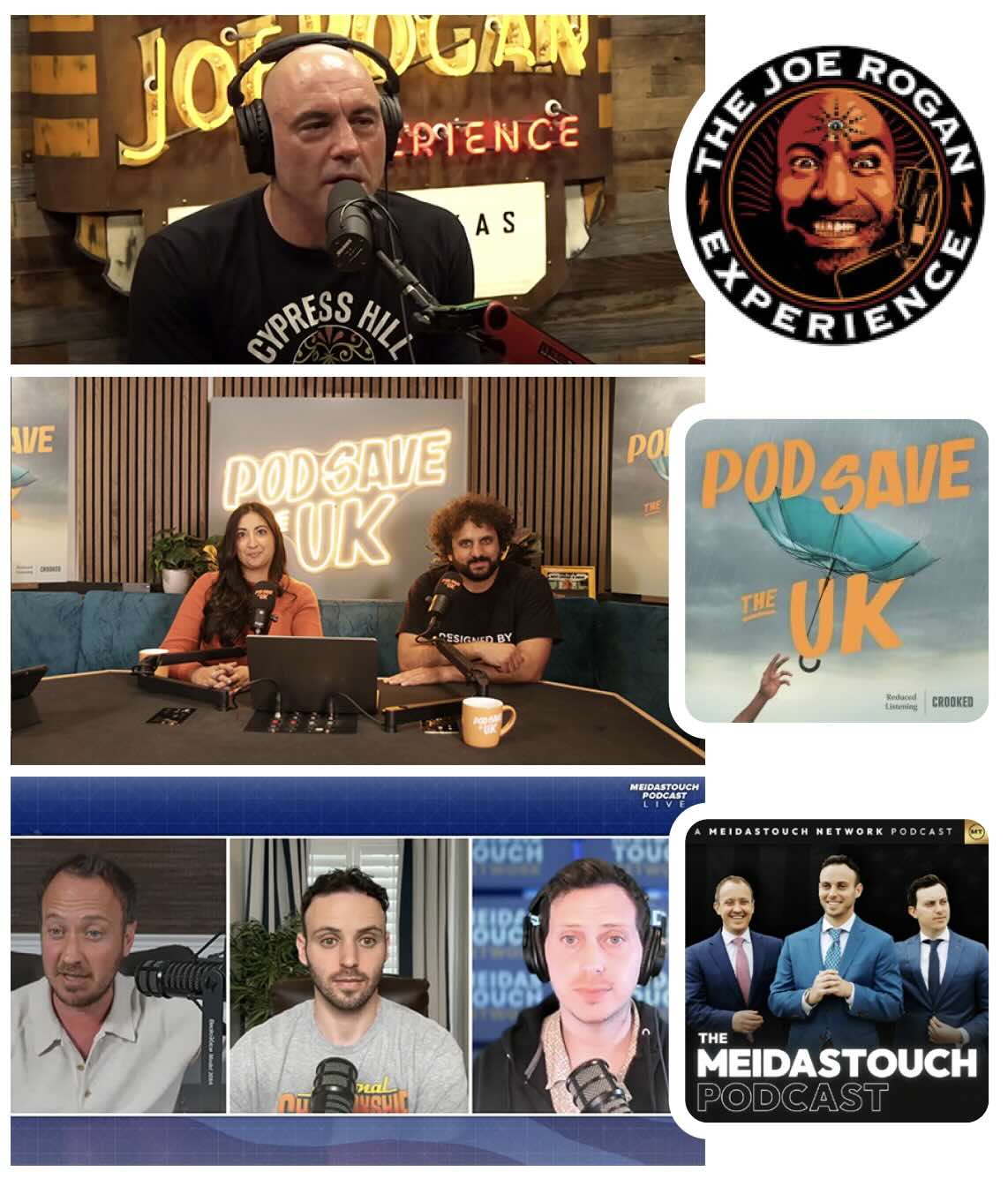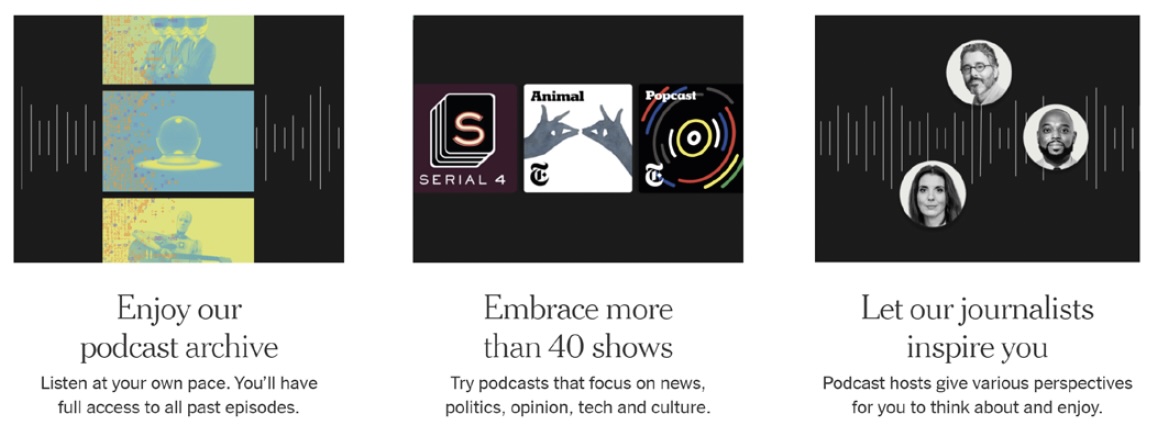News brands have, in recent years, leaned into podcasts – and they aren’t alone. Both Donald Trump and Kamala Harris made appearances on popular podcasts in the lead-up to the 2024 US election, following the example of French President Emmanuel Macron in 2023 seeking to reach younger people.1 This younger age profile of listeners is part of the appeal for news brands, along with the strong connection that many people have to their favourite podcasts.
Yet news podcast listening also remains a somewhat niche activity, ranging from 15% of people listening weekly in the US to 3% in Japan. Very few people (2% across 20 markets we have been tracking over time) say podcasts are their main source of news, with news podcasts instead playing a complementary role in people’s news diets. But the younger, richer, educated profile of regular news podcast listeners is attractive, so effort has been put in to reach them.
Against this backdrop, in this chapter we look at the different ways in which podcasts are developing across countries, including how the definition of ‘podcasting’ itself is blurring. This chapter focuses on three markets where we conducted additional in-depth qualitative research, supplementing our survey data. Interviews were done with 50 people in the US, UK, and Norway in order to add further context and understanding to a still-developing media format.
Our podcast on the findings
Spotify | Apple Podcasts | Transcript
What are people listening to, and how?
To get a broad picture of what the news podcast landscape looks like in different countries, we used an open-ended survey question to ask our respondents to name the news podcasts they listen to most regularly. After coding and analysing the responses, we can see interesting differences across the US, UK, and Norway.
In the US, where the news podcast market is most developed, the list of most-mentioned podcasts is topped by shows from well-established brands, as well as shows from independent social-first producers with opinionated hosts. Industry leader The Daily (New York Times) tops the list of most-named news podcasts, followed by NPR’s Up First. The BBC’s Global News Podcast also features in the top six shows – and the BBC is among the most frequently cited producers.
Most notably, beyond mainstream news brands, The Joe Rogan Experience features among the most named news podcasts, despite some US interviewees disagreeing about it being a news podcast at all, given the wide range of topics covered. Nevertheless, the show does regularly feature prominent guests who generate news stories from their appearances. It’s among a crop of right-leaning podcasts which have become highly influential in the US political sphere.2 Also featured in the top six most-mentioned shows in the US are the left-leaning MeidasTouch Podcast and Pod Save America, showing how podcasts from smaller independent producers can break through in a highly competitive market. These shows are filmed, with many people watching on YouTube – the most popular platform for podcasts in the country, with 50% of US podcast consumers using it (though we don’t know precisely how many people are watching versus listening). In the US, YouTube is consistently popular across age groups as an access point to podcasts, with Spotify being far more popular amongst younger people (50% among 18–34s) when compared to older people (24% of over-55s).
The UK market is similarly a mix of shows from well-established brands and newer entrants, though strong partisan opinion is less foregrounded than in the US. BBC Sounds is a popular platform to access podcasts, with 37% of podcast listeners using it, just below Spotify (41%). BBC Sounds proves far more popular with older people (48% of those 45+) compared to younger people (30% of those under 45), while the reverse is true for Spotify, following the pattern in the US.
The BBC’s Newscast and Americast appear among the most mentioned shows, as does the PoliticsJOE Podcast. A key story in the UK is also the success of a political analysis show – The Rest is Politics – from an independent producer (Goalhanger), challenging the dominance of the BBC in the audio space. The Rest is Politics and News Agents (Global Media) are the two most frequently cited shows, hosted by former journalists and/or political insiders who provide analysis of the news. Interviewees mention the appeal of these shows being their deep-dive approach, providing perspective on the day’s news. Rounding out the top six is Pod Save the UK, a spinoff show from its popular American counterpart.
The Norwegian market, meanwhile, is heavily concentrated, with shows from the country’s public broadcaster NRK taking up a third of all mentions. The most popular platform is the public service broadcaster app NRK Radio (63% of podcast listeners say they use it), reflecting the brand’s popularity in the country. The age disparity in listenership is similar to the UK: 72% of those aged 45+ use NRK Radio for podcasts, while 58% of under 45s do. Interestingly, the app remains popular with those aged 25-34 (67%) and 35-44 (60%).
Being a smaller market, this concentration of attention is not unexpected, as a small number of news brands take up most news consumption in the country. The top six most-mentioned podcasts all come from NRK and newspaper Aftenposten. Tabloid newspaper VG is also a popular producer of podcasts. The Norwegian market doesn’t strongly feature social-first or creator-led shows, instead being a brand-first audio market.
The rise of video podcasts
The popularity of podcasts on platforms like YouTube in the US signals a shift in the definition of ‘podcasting’. Podcasts are no longer just an audio experience, with many now being filmed and pitched as video-first. Joe Rogan podcast episodes regularly get over 3 million views on YouTube, with clips from the show often going viral.
Examples of video podcasts: The Joe Rogan Experience, Pod Save the UK and The MeidasTouch Podcast

What does this mean for news brands? The rise of video podcasts has seen some brands experimenting with filming their shows (e.g. Hard Fork from the New York Times), since podcasts are relatively easy to film and video also offers a marketing opportunity – videos can be clipped and highlight moments posted to platforms like TikTok, Instagram, and X (Monkcom et al. 2025).
So should news brands embrace video podcasts, if they haven’t already? Our interviewees in the US, UK, and Norway suggest caution for several key reasons. One drawback is that while hosts are often cited as a key reason for people listening to non-news podcasts (personality-led and entertainment shows), driving engagement and sometimes watching rather than listening, the importance of hosts in the news space is more limited for our interviewees, particularly in the UK and Norway. Audiences in these markets put much more emphasis on impartial deep analysis (getting information) than opinionated hosts. The appeal of hosts is more evident in the US, where the market is characterised more strongly by partisan personalities, but this doesn’t necessarily translate into a desire to watch.
Another drawback is the diminished add-on value. For non-news podcasts, such as comedy and entertainment, respondents mention wanting to see facial expressions, reactions from guests, and even what people are wearing. In the news space, people tend to just want information and expressed less desire to watch the host. Some genres of news podcasts, such as narrative storytelling, are also poorly suited to video unless much more production effort is put in, at which point respondents said they could just watch TV news instead.
Lastly, the how and why of news podcast listening contributes to the diminished appeal of video, since one of the unique values of news podcasts mentioned by interviewees is a podcast’s ability to slot into spaces where other forms of news consumption are not practical or possible, such as when driving, cooking, or at the gym.
What are the opportunities for news publishers looking to monetise podcasts?
The way that podcasts are embedded in people’s daily routines – and the strong connection many people have to their favourite shows – makes them a unique format and an appealing prospect for news publishers. Interviewees mention how different types of news podcasts fulfil particular needs throughout the day, such as informing them about the world’s events on the commute to work, learning something new during their lunch break, or being entertained by a lively chat show in the afternoon or evening. So does this habitual listening offer news brands a path to monetisation?
While the overall market is currently small, regular listeners are highly interested in news (71% of news podcast listeners are extremely or very interested in news, compared to 45% of non-podcast listeners). Willingness to pay for news podcasts is also relatively higher than when we typically ask this type of question: 46% of news podcast listeners in the US say they would be prepared to pay a reasonable price for news-related podcasts they like, with the figure being 39% in the UK and 41% in Norway.
In terms of monetisation strategies, ads and sponsorships have typically been a first port of call, and our interviewees in the US, UK, and Norway say they are comfortable with this. But news is outranked by comedy and sports podcasts when it comes to the share of ad revenue3 and the amount of ad money going into podcasts is a fraction of the overall spend on audio (Monkcom et al. 2025). So publishers have been approaching the economics of podcasts more widely, using them as a way to engender loyalty and encourage membership/subscription to the wider brand. Many publishers have included podcasts as part of their wider package of offerings, alongside news articles, games, and recipes. Another bundling strategy has been to pitch collections of shows.
The New York Times, for instance, focuses their subscription pitch on the bundle of 40+ shows they have, leveraging the popularity of hosts, as well as offering access to podcast archives and early access to episodes from Serial Productions. The Economist also advertises its bundle of shows with Podcasts+, including ‘all our weekly podcasts on global affairs, business, China, America, technology and more’. Meanwhile, Schibsted Media in Norway offers premium podcast content through its app Podme, where they emphasise exclusivity and ad-free listening. A subscription provides access to shows from brands like VG and Aftenposten, as well as Podme original content.
The pitch from New York Times audio

These larger brands benefit from having a catalogue of shows to offer – something that smaller brands don’t necessarily have. But this doesn’t mean standalone podcasts can’t monetise directly. It depends on the offering.
One of the most common themes associated with podcasts – and particularly news podcasts that people might consider paying for – is depth (see also Monkcom et al. 2025). This is made clear in the survey responses, where 73% of listeners say podcasts help them understand issues more deeply than other types of media.4 In our interviews, people associated podcast listening with learning, understanding, and gaining insights. Having high-quality, personally valuable information might be worth paying to access.
Uniqueness and exclusivity are also mentioned as possible reasons to pay, though the idea of putting existing free content behind a paywall is off-putting to many. Interviewees are more open to exclusive add-on content (which can be paid for on a one-off basis or as part of a membership) that doesn’t take away from the main free offering. In the US context, in particular, uniqueness is also tied to hosts, with some open to paying for content from their favourite personalities.
Motivations to pay for podcasts, though, are highly dependent. As we’ve found in other research (see Newman and Robertson 2023), audiences are somewhat stubborn when it comes to paying for any type of news content – and podcasts don’t escape this. Yet interviewees suggested this could be overcome in the right context.
Regarding other monetisation options pitched to interviewees, there was some interest in paying for one-off episodes (rather than an ongoing subscription which makes you feel ‘locked in’) if they offered something interesting like a prominent guest.
There was no appetite among interviewees for access to back catalogues, largely due to news having a shelf life. Donations were appealing for smaller independent shows and live podcast events were of interest to a few interviewees, though they did mention the potential cost and time investment as drawbacks.
Conclusion
A lot of news publishers have been leaning into podcasts in recent years, seeking to leverage the deep connection that people have with their favourite shows. The news podcast market is still relatively niche and fragmented, but the loyal audiences many podcasts have present a path to potential membership and monetisation.
At the present moment, ad-supported shows that showcase the brand and encourage loyalty are most appealing to audiences, but the bulk of advertising money is likely to go to only a handful of the most popular shows and the overall pie remains relatively small. Direct monetisation through podcast subscriptions is a harder pitch, with paywalling likely to be successful for only a few brands. The popularity of some hosts can also drive willingness to pay, but popularity on the scale of Joe Rogan can’t be engineered out of thin air. Freemium and value-added models are more likely to succeed with other (smaller) publishers because podcasts are not often people’s primary source of news, but a supplementary they seek out to add depth and understanding. This is where the value of news podcasts is and where memberships with add-on benefits might appeal.
Whether news podcasts are a fit with video is still an open question, with the most successful video-first podcasts tending to be in comedy and entertainment, rather than news. It is possible that audience behaviours could shift as video podcasts become more normalised, but their fit with the news genre is not obvious – and there is a risk of overinvesting in an increasingly crowded space.
The role that news podcasts play in people’s lives is a common throughline in our research and this is perhaps the most important focus. At present, it’s the why of podcast listening – depth, insight, analysis, understanding – and meeting people in the right moments throughout the day.
Footnotes
1 https://edition.cnn.com/2024/03/16/media/france-hugodecrypte-youtube-profile-travers-intl-cmd/index.html
2 https://www.mediamatters.org/google/right-dominates-online-media-ecosystem-seeping-sports-comedy-and-other-supposedly
3 US Podcast Advertising Revenue Study, IAB.
4 Across a basket of 20 markets where podcasts are well-understood as a format.


